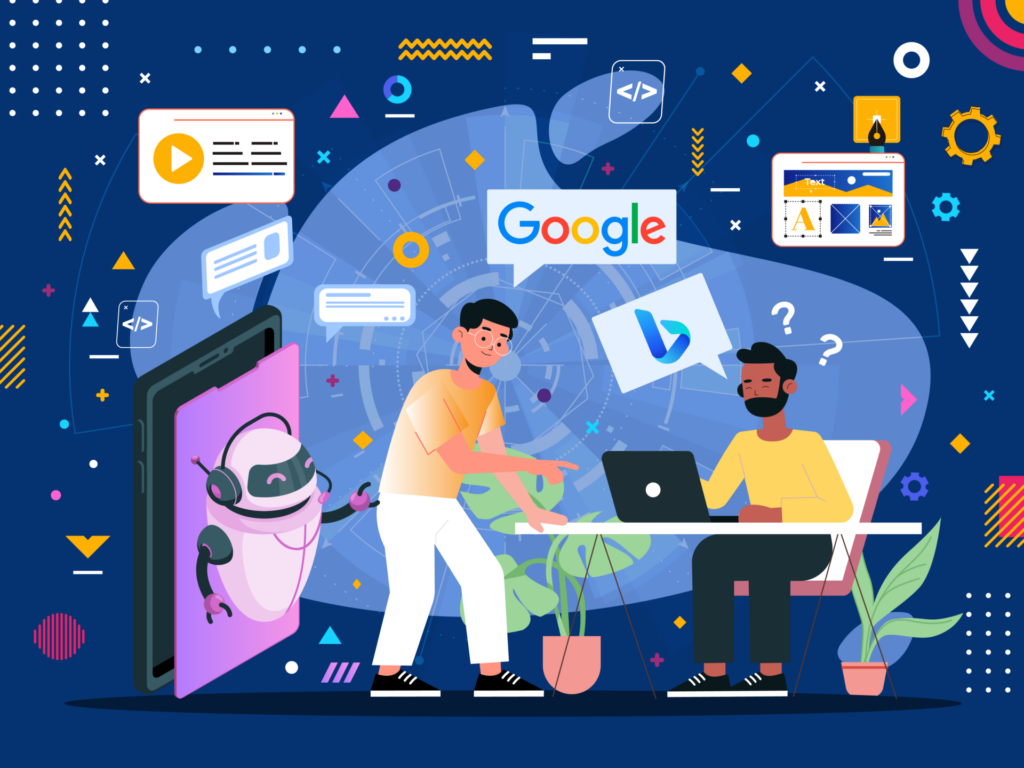Can Bing Chat AI Take Over Google Bard?
Over the years, we’ve seen some epic battles between search engine giants. We’ve watched as Google, Bing, and Yahoo have gone head-to-head, each vying for market share. And now, a new challenger has entered the arena–Bing’s chatbot AI.
Launching this experimental tool last February 7, 2023 put Microsoft ahead of the race–and forced Google to take Bing seriously as a challenger for the future of search.
But, the question is this: can Bing’s Chat AI take down Google Bard? Let’s probe further.
How Bing Chat AI Fares Now
Powered by OpenAI, Bing’s new chatbot was designed to deliver better search results and provide a new search experience for users–and it worked.
Bing now has 100 million daily active users. While that seems like a tiny number compared to the millions that still use Google today, it’s enough to make them declare a “code red” with their own experimental chatbot, Bard.
On March 8, 2023, Yusur Mehdi, Microsoft’s Director of Marketing, shared that Bing surpassed its 100 million daily active users after their Chat AI was launched a month ago. Here’s what Yusur Mehdi has to say about their progress on Bing’s new addition:
“Of the millions of active users of the new Bing preview, it’s great to see that roughly one-third are new to Bing. We see this appeal of the new Bing as a validation of our view that search is due for a reinvention and of the unique value proposition of combining Search + Answers + Chat + Creation in one experience.
Secondly not only are we seeing growth in new users, but we are seeing engagement growing as more people are conducting more searches daily. “
What can we glean from this? First, that Bing has greatly benefited from its launch first-debug later strategy, which Google failed to establish as a pioneer in the AI chat field. Safe to say that Google lost ground when it delayed its Bard launch over Bing’s ChatGPT.
And second, that Bing’s on the right track in reinventing the search experience. With more than a month of beta testing (and a few weeks of open testing for everyone who signed up for their waitlist), we can now take a better look at how Bing’s Chat AI performs.
How to Access Bing’s AI Chatbot
You’ll find Bing’s AI Chatbot as a new feature on their search bar. It’s under the “Let’s chat” button or the “Chat” button at the bottom of the search box. You can also click the “Chat” option on the Bing homepage.
Doing so will bring you to the chatbot page. Here, you’ll see that it’s quite different from your typical search bar–and more like chatting with another person in something like Google Teams or Slack.)
I’ve been testing it out myself for the last two weeks, and I consider it to be a significant improvement over the functionality and user experience of ChatGPT.
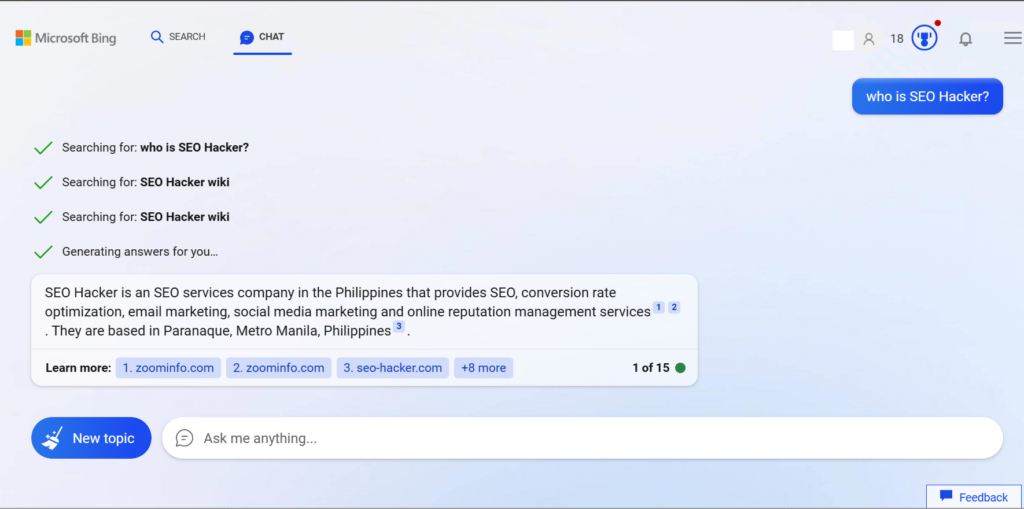
How Does Bing’s AI Chatbot Respond?
The ability to access the internet and current data is a significant improvement for New Bing. And it takes this a step further by including sources and footnotes in search results, which addresses one key issue when you use ChatGPT.
It’s also content-aware, much like ChatGPT. It will remember your previous searches, so you can ask follow-up questions for more information on your topic of interest, without having to start over. However, there is a limit of up to 2000 characters per question.
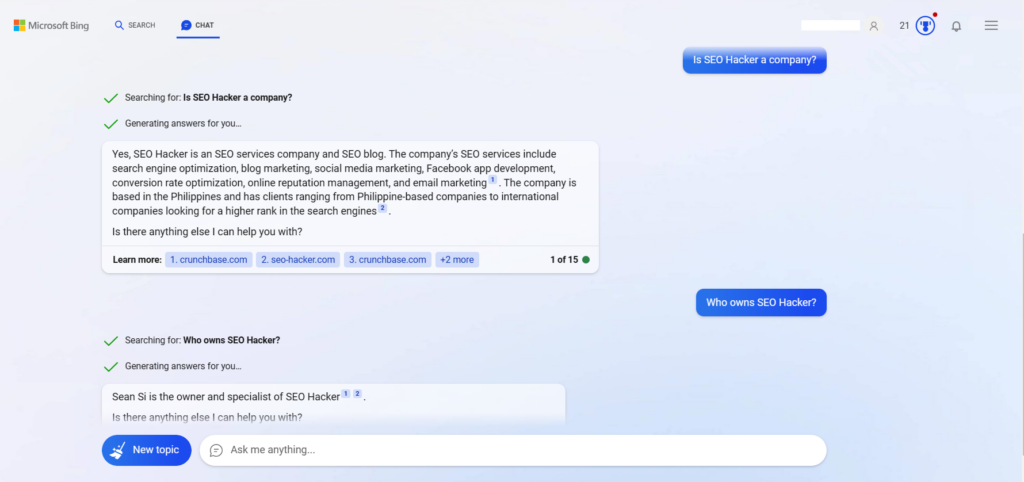
New Bing also includes chat prompts for other search options. When users select a prompt, such as “What is the meaning of SEO? “, it also provides some follow-up questions, such as “What is online reputation management.” This can lead to a more engaging conversation experience that scrolls to a different area of the website.
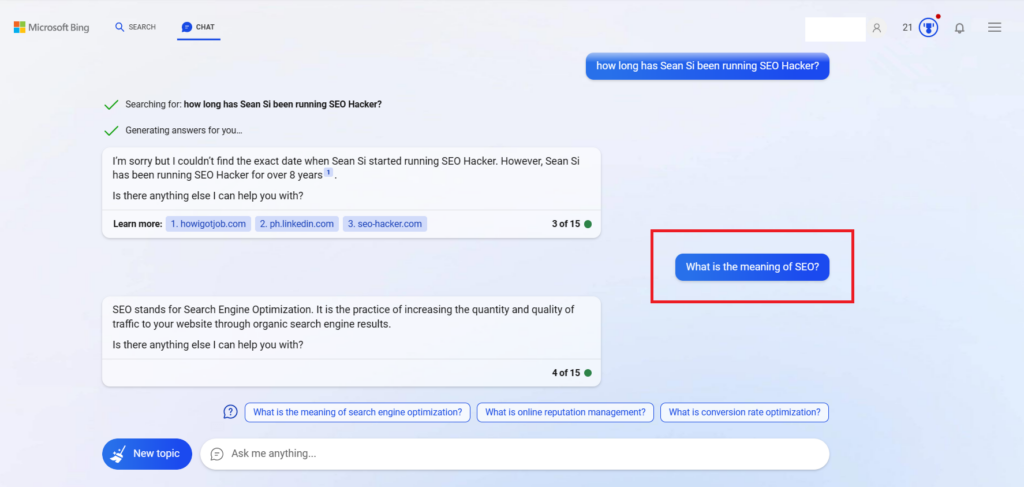
After testing New Bing over the last few days, I’m finding that the results are pretty helpful when choosing a prompt after searching.
Recent Updates with Bing’s AI Chatbot
Following the weeks since its initial launch, Microsoft has introduced several updates to the AI chatbot.
One of them is that it now offers replies in three different tones, in response to some of the earliest criticisms of the chatbot.
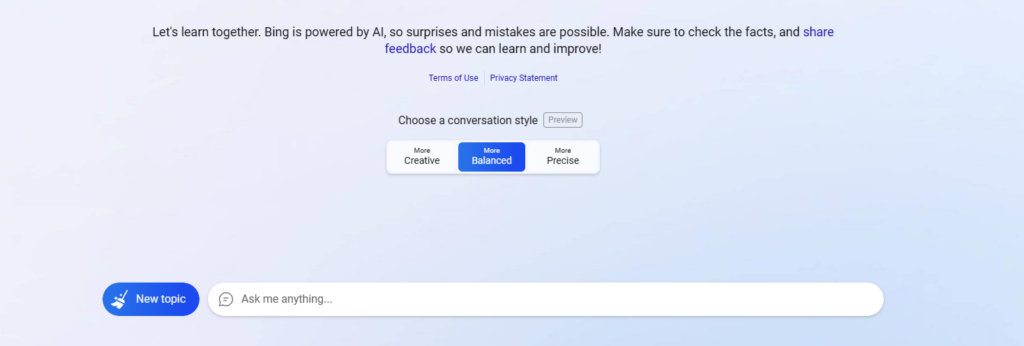
The default is set to “Balanced,” which generally creates neutral responses that do not take sides on a specific topic. Other options are “Creative,” which generates more playful and original responses, and “Precise,” which generates the most concise and factual responses.
Microsoft has also given another feature: the ability to generate images (which, at the time of writing, is currently a work in progress). Built on the DALL·E model, it allows users to generate images by typing the prompt “create an image,” followed by your instructions.
Lastly, the search function on the chatbot itself is still limited to only 15 queries per session, and 150 queries per day. You can keep track of how many you have left in each topic at the bottom-right of the most recent response Bing provides:
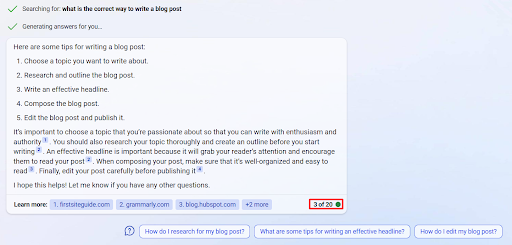
How Does Bing Chat AI Compare to Google Bard?
Building from the substantial amount of search behavior with ChatGPT, Bing comes out strong, showing a new paradigm of what users can gain from using a search engine.
At present, it also presents a new method of search that isn’t possible on Google, which means it can take some potential traffic away from Google–though that would only make a small dent in Google’s search volume.
And this isn’t to say that Google won’t contend with Bing. Google has long been the gold standard when it comes to finding information online. Its algorithm is sophisticated and efficient, able to sift quickly through vast amounts of data to provide relevant results in a matter of seconds.
At the time of writing, Google has just opened up its waitlist for Bard–but has yet to share anything substantial about its AI chat results. All we’ve seen so far is a very basic walk-through of Bard, and it doesn’t show much.
The one interesting thing that we do know is that Google wants Bard to improve on the Knowledge Graph Cards you often see in their SERPS, particularly when asking questions that have simple answers.
They’ve also stated that Bard’s responses are designed to answer NORA questions – queries with No One Right Answer. This is different from the approach being used by New Bing. You can check out a preview of how this works on Brodie Clark’s Twitter thread.
Comparing the two at face value, I think that the approach used by Bing centers on publishers, whereas Google centers the content itself. But then again, as these two tools are still under development, we’ll just have to see how far they go with their implementation.
Can Bing Chatbot AI Take Over?
When it comes to the question of whether Bing AI Chat can take over Google Bard, there are several factors to consider.
The most important is this: Google may not develop Bard in the same direction that Bing’s AI is going. It’s entirely possible that both AIs will end up providing completely different search functions. And if they do, then it is no use comparing the two.
But we can evaluate them from a tech standpoint, since both Bing Chat AI and Google Bard will be chatbot technologies that use artificial intelligence to interact with users and provide information or assistance. So here are some points to consider:
- User Experience: The success of any chatbot is greatly influenced by its user experience. A chatbot is more likely to be effective if it is simple to use, offers reliable information, and can comprehend user queries. In terms of user experience, Google has a long history and a more well-established track record of excellence. Bing Chat AI is constantly developing, though, so it might be able to catch up in terms of user experience.
- Features and capabilities: Each chatbot’s features and capabilities should be taken into account. Google Bard is currently under development to “distill complex information and multiple perspectives into easy-to-digest formats,” and may be compatible with other Google products, like Maps and Search. Google Bard reportedly also has a “Google It” button which is used to fact check the bot’s sources. In comparison, Bing Chat AI is likely not compatible with Microsoft’s other products, so may not have as many features and functionalities as Google Bard might have.
- Market share: Finally, market share is another factor to consider. Google is the dominant search engine, and Google Bard will be built into its search functions. This gives Google Bard a significant advantage in terms of visibility and accessibility. However, Bing Chat AI is also backed by a major tech company and has the potential to grow its market share over time.
It’s hard to say definitively whether Bing’s chatbot AI will eventually overtake Google Bard in terms of market share or popularity. However, one thing is certain—chatbots are becoming increasingly popular in search, and are already being used by some major companies like Amazon and Microsoft.
As more companies begin integrating them into their customer service systems, they will likely become even more commonplace in the near future.
What Can We Learn From Bing’s Chatbot?
Bing is the first search engine to showcase what AI-powered features–such as a chatbot function–could mean for search. This means that it’s also the first to show just how difficult and unpredictable it is to work with new AI tools.
Just take the beta tests with Microsoft’s Bing chatbot, which have been extensively documented by many over the past few weeks. This argument in particular is a good example of the surprises and mistakes it committed early on.
But thanks to the open beta tests, Microsoft was able to put in additional content-generation safeguards, beefing up OpenAI’s own built-in restrictions. And as Microsoft learns its lessons, I’m sure that the rest of the Search Engine industry is following along.
Microsoft’s new AI also presents a novel way to search. It opens a new era of interacting with information online because it’s conversational AI that taps into both a huge search database and powerful AI language models.
That said, there is still the looming risk of potentially serious consequences–AI models, even one as complex and as tested as Bing’s chatbot, may not be able to reliably sort fact from fiction. And we’ve yet to see any AI who can do so. Bard, fueled by Google’s extensive resources and development, also presented misinformation on the day of its big reveal.
Even so, there is now an open AI arms race amongst just about every Big Tech company. Meta just announced its intent to focus on generative AI, while Snapchat announced that it has an ongoing experiment with OpenAI, the same firm that Microsoft is working with for its AI-powered chatbot.
While I am interested to see where this takes us, I fear that the speed at which these companies are going might result in “experimental” features that are ultimately less credible or functional than standard search.
So, as fascinating as these tools are, I’d have to caution users on how they take in and interact with the information these conversational AIs provide.
Key Takeaway
Bing Chat AI’s early release has the potential to change the search landscape and SEO as we know it. It even has the potential to catch up to tech giants in terms of user experience, features, and integration capabilities.
But when it comes to Google Bard vs. Bing AI, the success of each chatbot will ultimately come down to how well it meets the needs of its users and how effectively it can differentiate itself in the market.
While it had a good start, the outcome is still uncertain as Google Bard is yet to be released to the public. We can, however, glean some very interesting insights as to how AI can transform search from Bing AI’s beta testing to its initial release.
Only time will tell if Bing Chatbot AI will be able to successfully compete with its rivals, but there’s no denying that its capabilities make it a tool worth investigating!
